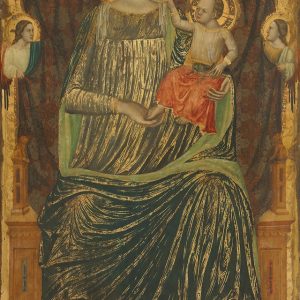In a short and brilliant essay of 1927, the then librarian of the Malatestiana of Cesena, Arturo Torquato Dazzi, foreshadowed the idea that the quadripetala rose, so frequent in the works of Rimini’s Malatesta, was attributable to Isotta degli Atti (lover and later third wife of Sigismondo) and that the butterfly, which appears in a dozen or more codices from the Malatesta library in Cesena, was attributable to Violante da Montefeltro (the only and most devoted wife of Malatesta Novello). Therefore beautiful, fiery and ardent like an Isolde rose, spiritual and gentle like a Violante butterfly.
We know that the rose is a pledge and symbol of love, and that the butterfly is an allegory of the soul; but today we certainly would no longer risk romantic combinations with the two Malatesta women. After all, the quadripetal rose, one of the most beautiful heraldic feats among those used by the Rimini Malatesta, is also well present in Cesena, in the capitals and frames of the library, in the miniatures of its codes and in various architectural elements. Perhaps, as has already been hypothesized, the Malatesta rose alludes to the special honor of the “golden rose” conferred by the popes on the Malatesta family on various occasions, to thank them for their precious diplomatic and above all military services.
As for the butterfly, it has certainly been used as a symbol of spirituality. And even it has even been referred to the Madonna. In fact, a Madonna of the butterfly also exists, but I only discovered it in these days, and it is the one that I reproduce here from the catalog of a beautiful exhibition by the painter Giovan Francesco Caroto, organized by the municipality of Verona (and open until October 2) . His painting, executed in the years 1510-15, depicts a Madonna with Child and from a stylistic and iconographic point of view it is normal for a good painter of the Venetian area (it is in a private collection, first panel on the upper left).
But those who look at it carefully will see a small unusual detail, even in the foreground, on the right arm of the Madonna’s old-fashioned chair: that is the representation of a modest white butterfly, I would say a very common Cavolaia (scientific name Pieris brassicae).
I don’t think that the painter (or the client) was interested in faithfully reproducing a particular type of butterfly, but he was certainly interested in adding this insect to the image to suggest to those who looked at it to consider specifically the spirituality of the Madonna and her purity; and, at the same time, to consider possible also for one’s own soul the metamorphosis that the insect had undergone, from voracious caterpillar to splendid butterfly: therefore from material man to spiritual man.
Butterflies had not been seen in paintings for almost a century: only late Gothic painters, such as Pisanello, had sometimes depicted them in the backgrounds of princely portraits, perhaps to allude to the qualities of the characters.
There are many Madonnas called the cat, the swallow, the goldfinch, the sparrow, etc. On the other hand, very rare, indeed very rare, are those that take their name from insects, such as this Veronese work. To which I can only add a Madonna of the grasshopper, in a beautiful, much older panel, from the fourteenth century in Rimini, attributed to Baronzio and kept in the National Gallery in Washington (dep. SH Kress, box on the top right). Many people from Rimini have seen it and know it, because in 1995 it was exhibited in Rimini in the exhibition on Rimini’s fourteenth-century painting (in whose catalog it is reproduced on p. 265).
I believe that Federico Zeri was the first to give it this name, in a conference in 1995.
It really took a weird artist, it will be thought, to represent Jesus in the womb of the Madonna holding a large insect so unusual, ugly, harmful and lucky! However, this is not a simple eccentricity. Since the insect in question would be the symbol of paganism converted for the merits of Christ, the image of him in the hands of Jesus would be more than justified, it has been written.
But it is much more probable (and simple) that our grasshopper wants to recall the story of St. John the Baptist described in the eight panels that originally flanked that Madonna in a large dossal now broken down. In fact, of St. John, who lived and preached in the desert of Judah, the evangelist Matthew (3, 4) tells us that he ate only “locusts and wild honey”. Here I propose the layout of this beautiful dossal (according to the ideal “reconstruction” of K. Chistianssen, 1982), which must have been more than two meters wide.
Unfortunately, his tables are now dispersed in many foreign museums, and we ignore their provenance and history.
There are several Madonnas called grasshoppers around, especially in southern and insular Italy, invoked against the invasion of these insects (In the opening image, reconstructive graphic scheme of the Dossale with the stories of St. John the Baptist, who has in the center, the Madonna now in Washington, drawing of pgp 1987). In Calatafimi (in the province of Trapani) the Madonna of the locusts is even the protector of the city, for having removed a voracious swarm of locusts from the area in 1655. But all these Madonnas generally have the usual iconography of the Madonnas “in majesty” , which have nothing to do with grasshoppers.

